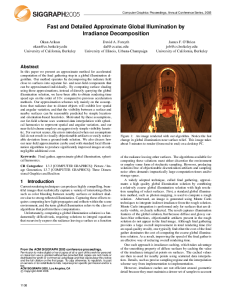Fast and Detailed Approximate Global Illumination by Irradiance Decomposition
Abstract
In this paper we present an approximate method for accelerated computation of the final gathering step in a global illumination algorithm. Our method operates by decomposing the radiance field close to surfaces into separate far- and near-field components that can be approximated individually. By computing surface shading using these approximations, instead of directly querying the global illumination solution, we have been able to obtain rendering time speed ups on the order of 10x compared to previous acceleration methods. Our approximation schemes rely mainly on the assumptions that radiance due to distant objects will exhibit low spatial and angular variation, and that the visibility between a surface and nearby surfaces can be reasonably predicted by simple location- and orientation-based heuristics. Motivated by these assumptions, our far-field scheme uses scattered-data interpolation with spherical harmonics to represent spatial and angular variation, and our near-field scheme employs and aggressively simple visibility heuristic. For our test scenes, the errors introduced when our assumptions fail do not result in visually objectionable artifacts or easily noticeable deviation from a ground-truth solution. We also discuss how our near-field approximation can be used with standard local illumination algorithms to produce significantly improved images at only negligible additional costs.
Citation
Okan Arikan, David A. Forsyth, and James F. O'Brien. "Fast and Detailed Approximate Global Illumination by Irradiance Decomposition". In Proceedings of ACM SIGGRAPH 2005. ACM Press, July 2005.









